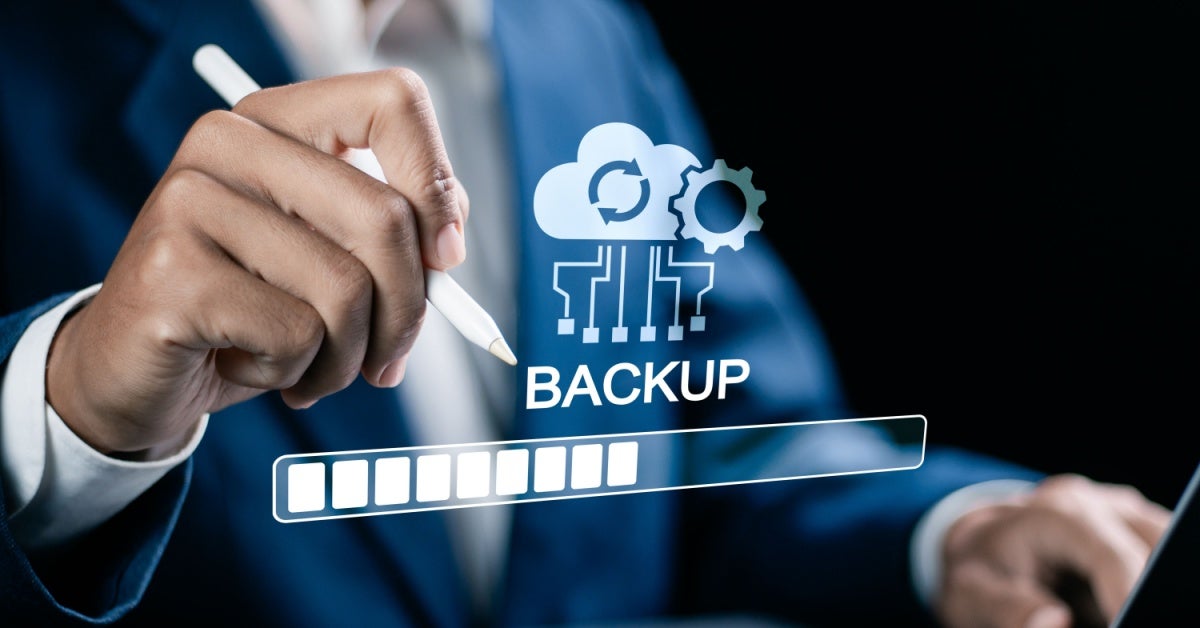Data backup and recovery refer to the process of creating extra copies of important information and restoring that information if it gets lost or damaged. These practices help businesses keep going even after technical failures, cyberattacks, or unexpected events like natural disasters. Without a proper system in place, recovering lost data can be slow or even impossible, which can interrupt operations and cause financial damage. By having a clear plan, companies can avoid long downtimes and reduce the risk of permanent data loss.

Types of Data Backup
There is no one-size-fits-all method for backing up files. The right approach depends on how often your files are updated, how much space you have, and how quickly you need to get things back up and running after a problem. Below are the main types, each with its pros and trade-offs.
Full Backup
This method copies everything — all your files, folders, and systems in one go. Because of the size of the job, it takes more time to finish and needs more storage space. That said, it makes things much simpler if you ever need to restore. You only have to pull from one backup file, and you are back to where you were.
People often schedule full backups once a week or once a month, depending on how much the data changes. While not practical to do daily for larger systems, it is a reliable safety net to fall back on.
Incremental Backup
This method focuses only on the changes made since the last backup, whether full or incremental. It is much quicker and takes up less space because you are only saving new or updated files.
However, there is a catch. If you ever need to restore your data, you must gather the full backup and every single incremental backup that came after it. This process can take longer and leaves more room for things to go wrong if one of the pieces is missing or damaged.
Differential Backup
This is a sort of middle ground between full and incremental backups. It saves every file that has changed since the last full backup, regardless of how many times you have run a differential backup in between.
The size of these backups will grow each day after a full backup until a new one is made, but the restore process is simpler than with incremental backups. You only need two sets of files: the most recent full backup and the latest differential backup.
Choosing the Right Approach
There is no single method that works for everyone. If storage space is tight and you need daily updates, incremental backups might make sense. If you value faster recovery and can spare the space, differential or regular full backups may be a better fit. What matters most is picking a setup that balances speed, storage, and reliability for your needs.
Difference Between Backup and Recovery
The two terms are often mentioned together, but they refer to different actions:
Backup
This step involves making copies of important information and keeping them in a safe place. These copies might be stored on physical drives, off-site servers, or cloud storage. The goal is to create a fallback option in case something goes wrong with the original files. Backup can include anything from individual documents to entire systems.
The copies are usually made on a schedule, depending on how often the original files change. Some systems back up everything once a day. Others focus only on new or changed data to save time and storage space.
Recovery
This step is about putting things back the way they were before something went wrong. If files are deleted by mistake, damaged by a system failure, or made unusable by a cyber threat, recovery allows you to restore them using the saved copies.
The success of recovery depends on how recent and complete the backup is. If the most recent copy is from a week ago, anything added since then might be gone. That is why regular backups are important. Good recovery tools and routines help reduce downtime and avoid the stress of starting from zero.
Types of Data Recovery
The way data is recovered depends on the cause of the loss:
Logical Recovery
Used when files are deleted by mistake, corrupted by software errors, or affected by malware. The hardware is still working, but the files are no longer accessible without special tools.
Physical Recovery
Needed when the storage device is damaged, like a broken hard drive or server. This usually requires expert help and special tools to retrieve the data.
Having both options available increases the chances of successful recovery, no matter what happens.
Disaster Recovery Backup
This approach focuses on keeping backup data in a separate and safe location. It is used in situations where major events, such as fires, floods, or large-scale cyberattacks, damage the primary systems. Offsite backups, duplicated systems, and regular testing are key parts of this strategy. With everything in place, businesses can resume operations faster and with fewer problems.
Data Sources Typically Needing Recovery
Some data needs more protection due to its importance to daily operations:
- Databases: Often hold customer records, transactions, and other vital information. Backups should happen often.
- File Servers: Store documents and work files. These need regular backups to avoid delays in work.
- Virtual Machines: Run multiple systems on a single device. These need specific tools to back up both data and system settings.
- Cloud Services: Even cloud storage can be at risk due to outages or cyberattacks, so backups should be made outside the main platform.
By identifying which systems are most important, companies can focus their efforts where they are needed most.
Importance of a Data Backup and Disaster Recovery Plan
Having a proper plan can help businesses in several ways:
- Business Continuity: Systems can get back online faster, reducing downtime.
- Data Accuracy: Regular backups help make sure that information stays correct and up to date.
- Compliance: Some laws and regulations require companies to protect certain types of data.
- Lower Risk: With a plan in place, the damage caused by data loss is smaller and easier to manage.
Updating and testing the plan regularly makes it more effective in real situations.
Role of Data Deduplication in Backups
Data deduplication helps by removing duplicate copies of files and only storing what is different. This reduces the amount of space needed and can make the backup process quicker. By only saving what is necessary, companies can lower their storage costs and speed up both backups and recoveries.
Key Terms in Backup and Disaster Recovery
Here are a few terms that are often used:
- Recovery Time Objective (RTO): The longest acceptable time it takes to get systems running again after a failure.
- Recovery Point Objective (RPO): The amount of time between the last backup and the failure. It reflects how much data could be lost.
- Failover: Switching to a backup system when the main one stops working.
- Failback: Returning to the original system after repairs or restoration.
- Disaster Recovery as a Service (DRaaS): Using cloud services to restore data and systems during emergencies.
Knowing what these terms mean helps in planning and making better decisions.
Importance of Backup and Recovery
Both backup and recovery are essential parts of any data protection plan. They help prevent data loss, support daily operations, and ensure businesses meet legal and industry requirements. Without a reliable system, even a small issue can become a big problem. Putting time and effort into a proper setup helps avoid bigger risks later on.
Modern vs. Traditional Backup and Recovery
Here is how older and newer approaches compare:
| Aspect | Traditional Backup and Recovery | Modern Backup and Recovery |
|---|---|---|
| Cost | High costs due to separate hardware and software | Lower costs with all-in-one solutions |
| Performance | Slow backups and more errors | Faster backups with automation |
| Scalability | Harder to expand and manage | Easier to scale and maintain |
| Data Management | Data is scattered across systems | Centralized data handling |
Modern setups often require less effort and offer better results, especially for growing companies.
Sangfor's Modern Approach to Backup and Recovery
Sangfor keeps backup and disaster recovery straightforward. Everything runs on one platform so you do not need separate systems or vendors. The setup handles everything — backing up, recovering, testing, and keeping things running even during an outage.
All-in-One Setup
Instead of patching together tools from different providers, Sangfor keeps it simple. Backup, recovery, failover, and cloud support all work together in one place. No need for extra software or complicated handoffs. This setup reduces confusion and delays during critical moments.
Fast Failover and Failback
If a server or system fails, you can switch to a backup in just a few clicks. Recovery time can be as short as two to five minutes. When it is time to go back to your main system, only the new or changed data needs to be sent back — which speeds things up and saves resources.
Flexible Backup Options
The platform supports a range of recovery points — from every second to hourly — based on what each application needs. If a file changes often, it can be backed up more frequently. If not, it can follow a less aggressive schedule to save space.
Continuous Protection
Even if a connection drops mid-backup, the system resumes from where it stopped, not from the beginning. This avoids wasting time and bandwidth.
Security Built In
Backups are compressed and encrypted before they are sent out. This saves bandwidth and keeps data protected at the same time. Compression uses the LZ4 method, while encryption is handled with AES 256.
Test Without Risk
Companies can run disaster recovery drills at any time without affecting live systems. This helps confirm everything works as expected — before a real issue happens.
Visual Monitoring
A clean, easy-to-use dashboard shows backup and recovery progress, failover status, and system health. You do not need to be a specialist to manage it. It is built so anyone in IT can track what is going on without sorting through logs or command lines.
Fast Setup, No Extra Layers
The whole system can be up and running quickly. Just activate a license, follow a guided setup, and start protecting your data. No outside software, no complex integration — it is ready to go.
Sangfor’s aCloud Backup and Disaster Recovery Solution helps businesses stay ready without adding stress. It cuts down on time, lowers the risk of mistakes, and keeps services online when something goes wrong — whether it is a server crash, a cyber threat, or something else entirely. By adopting our integrated backup and recovery solution, organizations can enhance their data protection strategies, reduce operational complexities, and ensure that critical systems remain available and secure.
Frequently Asked Questions (FAQs)
Data backup and recovery refer to two key activities that help protect information. The first part, backup, means creating a secure copy of important data so it can be kept safe in case something happens. This could include files, folders, databases, or even whole systems. The second part, recovery, involves restoring that data if it gets deleted, damaged, or becomes unavailable due to hardware failure, software issues, or cyberattacks. Together, these steps help make sure that important records and tools can be brought back without starting from scratch.
Backing up data gives people and businesses a safety net. Mistakes happen and files get deleted, systems crash, and threats like malware or ransomware can make data useless. Having a reliable backup means you do not lose everything. It also helps companies keep working without lengthy delays. Without backups, the cost of recovering data can be high, and in some cases, the information might be gone for good. A well-maintained backup allows operations to continue with fewer interruptions and protects against losing months or years of hard work.
There are three main ways to back up data:
- Full Backup: This makes a complete copy of everything. It is the most thorough but also takes the longest and uses the most space. It is often done once a week or a month, depending on the amount of data.
- Incremental Backup: This only saves changes made since the last backup. It is much faster and saves space, but to recover everything, you will need all the earlier versions in the correct order.
- Differential Backup: This keeps all changes since the last full backup. It uses more space than incremental but is quicker to restore.
Choosing one or combining them depends on how often data changes and how quickly it needs to be restored if something goes wrong.
Regular backups focus on saving data so that it can be restored if it gets deleted, corrupted, or lost. These backups are usually scheduled to protect important files or databases. Disaster recovery, on the other hand, includes a broader plan. It prepares an entire system from networks, devices, and applications for sudden and serious events like natural disasters, fires, or cyberattacks. It is not just about restoring files; it is about getting everything back in working condition with as little delay as possible. Backup is a part of disaster recovery, but recovery also includes planning, tools, and actions to help keep everything running or bring it back quickly after a major issue.





